Lenses to buy for taking pictures with Canon 5D Mark III.
Canon EOS 5D Mark III features a full-frame 22.3MP CMOS sensor that might seem a bit dated if you compare it to the recent models. However, it still delivers a remarkable performance, especially together with a realiable lens. Autofocus seems to work quite promptly and with a high level of detail thanks to the 61-point AF system with 41 cross-type points.
As it is a high-quality camera, it’s important to use it with the best lens for Canon 5D Mark III that will help you make the most out of its capabilities. Here, you will find detailed reviews of the best options available on the market. I have tested various models compatible with the Canon 5D Mark III and will tell you in detail about the best kit, wide-angle and telephoto zoom lenses your money can buy.
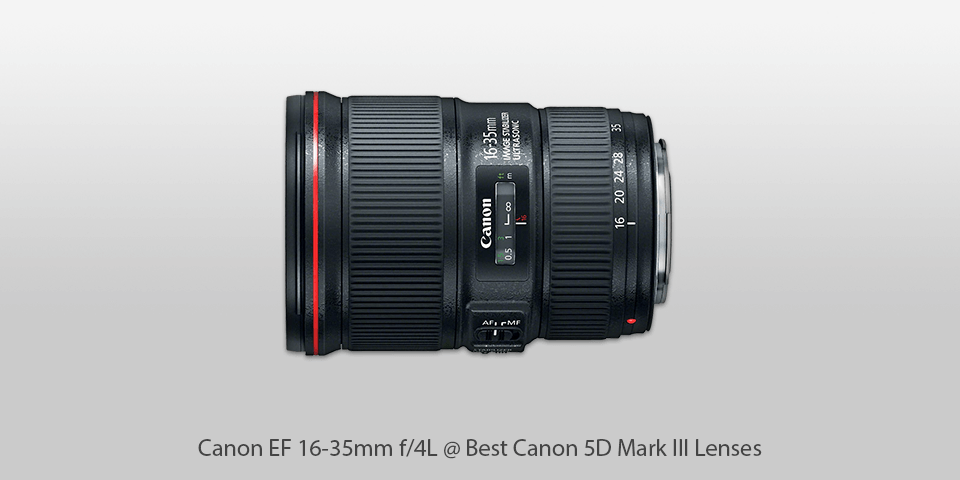
Mount: Canon EF | Diaphragm blades: 9 | Autofocus: Yes | Min focus distance: 0.28m | Max magnification: 0.22x | Filter thread: 82mm | Dimensions (WxL): 88.5 x 127.5mm | Weight: 790g
⊕ A small focal length
⊕ Full-frame
⊕ An f/2.8 aperture
⊕ High image quality
⊖ Expensive
⊖ No image stabilization
The EF 16-35mm f/2.8L III USM is a wide-angle lens that can be used both by seasoned photographers and beginners. Its max f/2.8 aperture will suffice for capturing photos in poor lighting and unfavorable weather conditions.
This best lens for Canon 5D Mark III handles the depth of field perfectly regardless of magnification. It is designed with special elements boasting Subwavelength and Air Sphere coatings that keep reflections under control while minimizing ghosting and flare.
As the result, the lens produces a clear image without noticeable aberrations. Its construction is dust and water-proof, which adds to its durability.
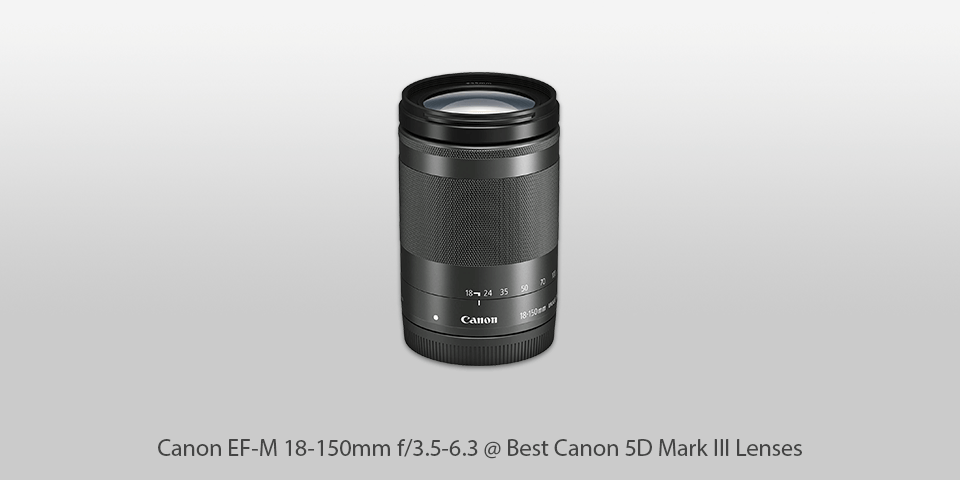
Mount: Canon EF | Diaphragm blades: 9 | Autofocus: Yes | Min focus distance: 0.25m | Max magnification: 0.31x | Filter thread: 55mm | Dimensions (WxL): 60.9 x 86.5mm | Weight: 300g
⊕ Portable
⊕ 8.3x magnification
⊕ A highly detailed image
⊕ Image stabilization
⊖ Dim corners when taking photos in RAW
⊖ A mount is made of plastic
The EF-M 18-150mm f/3.5-6.3 IS STM comes at $499.99 which makes it a perfect choice for those who are looking for a budget all-in-one model. It is known for its long zoom range and a portable design. The lens is compatible with EOS M cameras.
While it shares some disadvantages with other large-magnification Canon EOS 5D Mark III lenses, such as a narrow max aperture, blurry edges and visible barrel distortion at 18mm, it still can be considered as one of the best long-zoom mirrorless models.
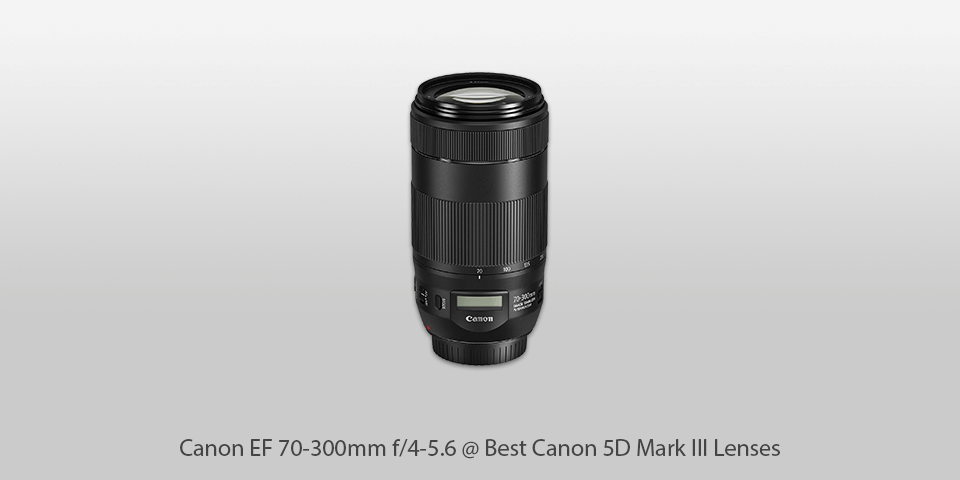
Mount: Canon EF | Diaphragm blades: 9 | Autofocus: Yes | Min focus distance: 1.2m | Max magnification: 0.25x | Filter thread: 67mm | Dimensions (WxL): 80.01 x 145.54mm | Weight: 710g
⊕ Small-sized
⊕ Integrated IS
⊕ Full-frame coverage
⊕ A hefty price
⊖ Blurry image
⊖ Aberrations at high magnification
The Canon EF 70-300mm is a lens with a variable f/4.5-5.6 aperture and image stabilization feature. You might need to save up a little to purchase it as it costs $1,399, however, its quick and virtually silent autofocus makes it well worth its price.
Thanks to the latest NANO USM technology, it delivers top-level performance even when you are capturing footage. For perfect sharpness across the frame, it is equipped with the IS system. This best lens for Canon 5D Mark III reduces shake and blur for up to 4 stops of shutter speeds.
The construction features diffractive optics, which contributes to a small size of the lens. However, this lens has the subpar image quality which makes it a less attractive option in comparison to standard-sized models.
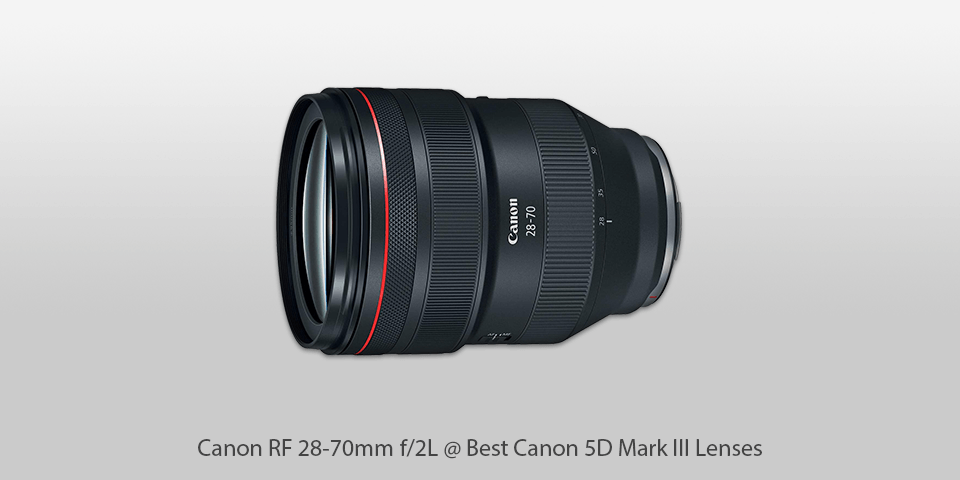
Mount: Canon EF | Diaphragm blades: 9 | Autofocus: Yes | Min focus distance: 0.39m | Max magnification: 0.18x | Filter thread: 95mm | Dimensions (WxL): 103.8 x 139.8mm | Weight: 1430g
⊕ Decent aperture
⊕ Remarkable resolution
⊕ Sturdy build, weather-resistant
⊕ Fluorine-coated elements
⊖ Bulky
⊖ Overpriced
The Canon RF 28-70mm F2 L USM can easily beat its competitors when it comes to edgy design, wide-angle coverage and telephoto zoom capabilities. What’s more, it features an f/2 aperture that adds to the overall performance.
However, it might cost you an arm and a leg to purchase it. If you decide on this option, be ready that it will make your camera much heavier. Besides being well-put-together, it delivers decent image quality.
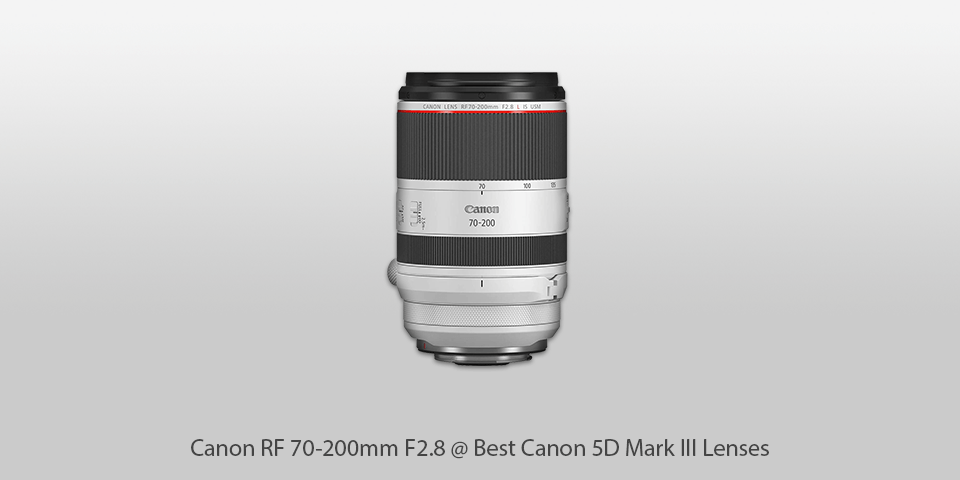
Mount: Canon EF | Diaphragm blades: 9 | Autofocus: Yes | Min focus distance: 0.7m | Max magnification: 0.23x | Filter thread: 77mm | Dimensions (WxL): 89.9 x 146mm | Weight: 1030g
⊕ Smallest of its kind
⊕ Great optics
⊕ OIS
⊕ 1:4.3 macro focus
⊖ A tad too expensive
⊖ Tripod foot doesn’t meet the Arca standard
The Canon RF 70-200mm F2.8 L IS USM is a high-end telezoom lens for full-frame mirrorless cameras that will add a professional quality to your photos. It was designed specifically for the EOS R and costs a staggering $2,699. Its design makes it the best option for those who specialize in event and landscape photography.
This lens allows you to take photos of your subjects from afar. While it costs $600 more than the Canon EF 70-200mm F2.8 that can be used with SLR cameras, it’s well worth the price you pay for it. The optical system of this landscape lens for Canon 5D Mark III is second to none, while the retractable design makes it a perfect choice for those who travel a lot.

Mount: Canon EF | Diaphragm blades: 9 | Autofocus: Yes | Min focus distance: 2.8m | Max magnification: 0.2x | Filter thread: 95mm | Dimensions (WxL): 105 x 260.1mm | Weight: 1830g
⊕ Impressive sharpness
⊕ Comes with a tripod collar and hood
⊕ Quick focusing
⊕ Top-notch image stabilization
⊖ Some signs of chromatic aberration
The Sigma 150-600mm f/5-6.3 DG OS HSM Contemporary weighs too much and might seem too bulky, especially if you are used to more compact models. It covers a full-frame sensor and is solidly built. Featuring a powerful image stabilization system, it allows you to take sharp shots even while using a camera handheld at slow shutter speed.
However, the quality of your shots will be better if your subjects don’t move too quickly. After thorough testing, I can conclude that it delivers great sharpness across the frame.
You will notice some chromatic aberration and pincushion distortion, though. This best lens for Canon 5D Mark III is marketed for wildlife and sports photographers and is a great value for money.
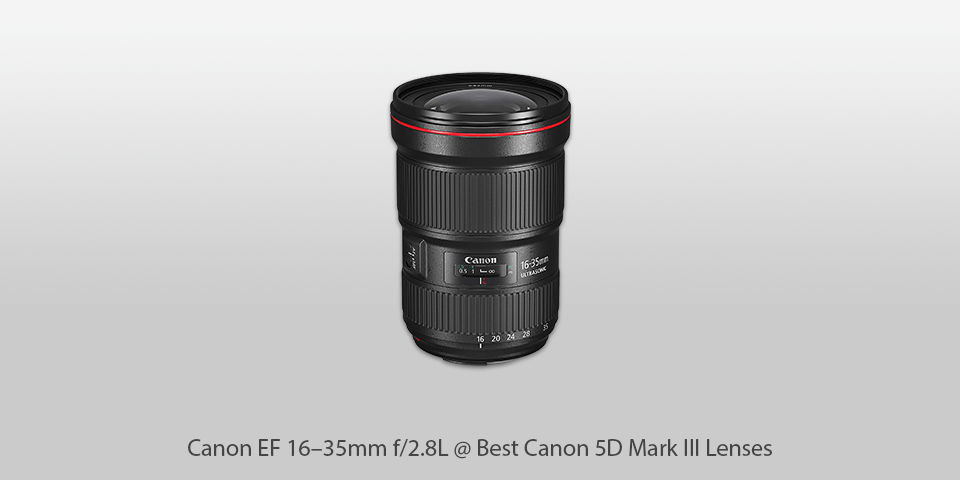
Mount: Canon EF | Diaphragm blades: 9 | Autofocus: Yes | Min focus distance: 0.28m | Max magnification: 0.22x | Filter thread: 82mm | Dimensions (WxL): 88.5 x 127.5mm | Weight: 790g
⊕ Wide-angle capabilities
⊕ Covers a full-frame image sensor
⊕ A bright f/2.8 aperture
⊕ Perfect image quality
⊖ No image stabilization
The Canon EF 16-35mm f/2.8L III USM exploits some technological advantages of the previous version that was sold at $1,700. Part of its appeal is that it boasts a better optical system. It has a great max aperture which contributes to the edge-to-edge sharpness of the image.
The lens delivers superior performance if you compare it to the earlier version and other zoom models with similar magnification capabilities. If you want to make the most out of your camera, pick this 16-35mm lens.
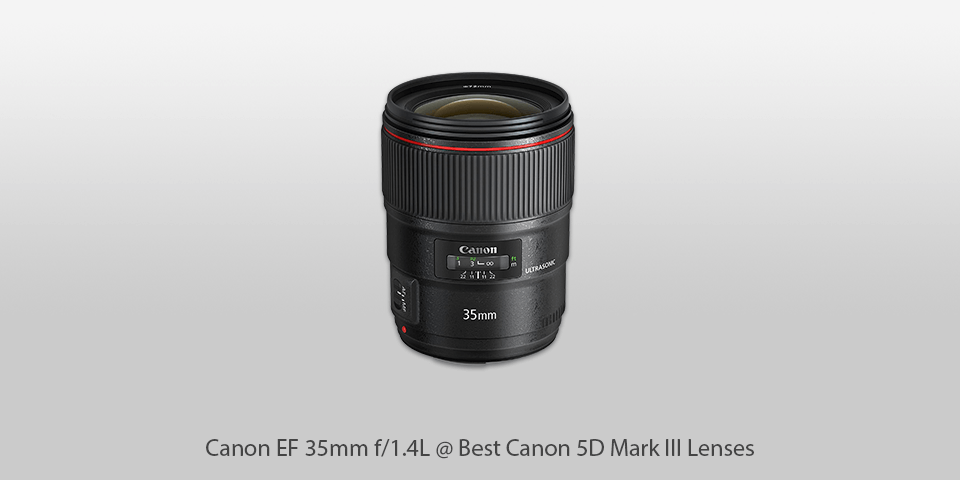
Mount: Canon EF | Diaphragm blades: 9 | Autofocus: Yes | Min focus distance: 0.28m | Max magnification: 0.21x | Filter thread: 72mm | Dimensions (WxL): 80.4 x 105.5mm | Weight: 760g
⊕ High sharpness
⊕ BR Optics reduces color fringing
⊕ 1:4.8 magnification ratio for close-ups
⊕ Wide aperture
⊖ Pricey
If you are thinking about upgrading to a prime lens, take a look at the Canon EF 35mm f/1.4L II USM. While its field of view is pretty average, it is sufficient for wedding and street photography. This lens can even be used by war photographers.
This prime lens for Canon 5D Mark III is sold at a hefty price, as it delivers remarkable performance even when used at an f/1.4 aperture. For better shooting experience, try mounting it on the EOS 5DS R, the high-resolution camera from Canon sold at Amazon for $1,399.
This model is a must for anyone who wants to find a 35mm lens and has some cash laying around.
| Image | Name | Features | |
|---|---|---|---|
 |
Canon EF 16–35mm f/2.8L
Our Choice |
CHECK PRICE → | |
 |
Canon EF-M 18-150mm f/3.5-6.3
Professional |
CHECK PRICE → | |
 |
Canon EF 70-300mm f/4-5.6
Budget |
CHECK PRICE → |

When you are choosing a lens, pay attention to its focal length as it directly influences the image quality. Some models come with a variable focal length, which makes them suitable for different applications.
A long focal length is great for zooming in on faraway subjects while a short focal length is perfect for macro photography. Think carefully about which area you want to specialize in and pick a Canon 5D Mark 3 lens that will enable you to take amazing portraits or photos of beautiful vistas.
Another thing you need to consider is how wide a lens’ aperture is. The size of the opening is directly connected to the light-gathering capabilities of a lens.
An f/1.4 lens collects more light in poor lighting conditions that an f/5.6 one. If you prefer taking photos of sunny days, you won’t face any difficulties when using an f/4 or f/5.6 lens. Those who take pics at dusk or dawn will appreciate an f/1.4 aperture.

As many photographers tend to take photos handheld, it’s important to pay attention to image stabilization. The optical IS minimizes shake and virtually eliminates any sign of blur. Camera shake becomes more noticeable at high magnification, so you need to buy a wide angle lens for Canon 5D Mark III with a long focal length and the integrated image stabilization system.
If you have an 18-55 EF-S lens, note that it was created specifically for crop-sensor cameras. It’s impossible to use it as a replacement for Canon 5D Mark III lenses covering a full-frame image sensor. You can use EF-S lenses with other camera models. Their key advantage is that a rear element of such lenses is closer to the sensor, which accounts for reduced aberration.
The Canon 5D Mark III was introduced back in March 2012. Recently, it has been announced that the company will keep producing it to meet the increasingly strong demand.
It’s 150,000.
When people are talking about EF-S, they are referring to the short back focus. The first EF-S lens was introduced in 2003 when Canon presented its EOS Digital Rebel range of DSLR cameras.

 Rating
Rating